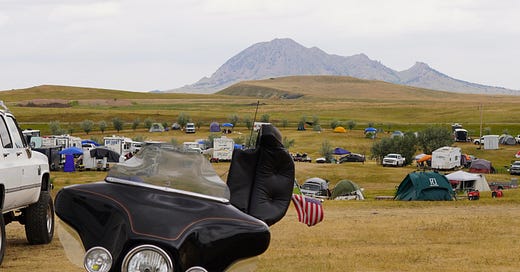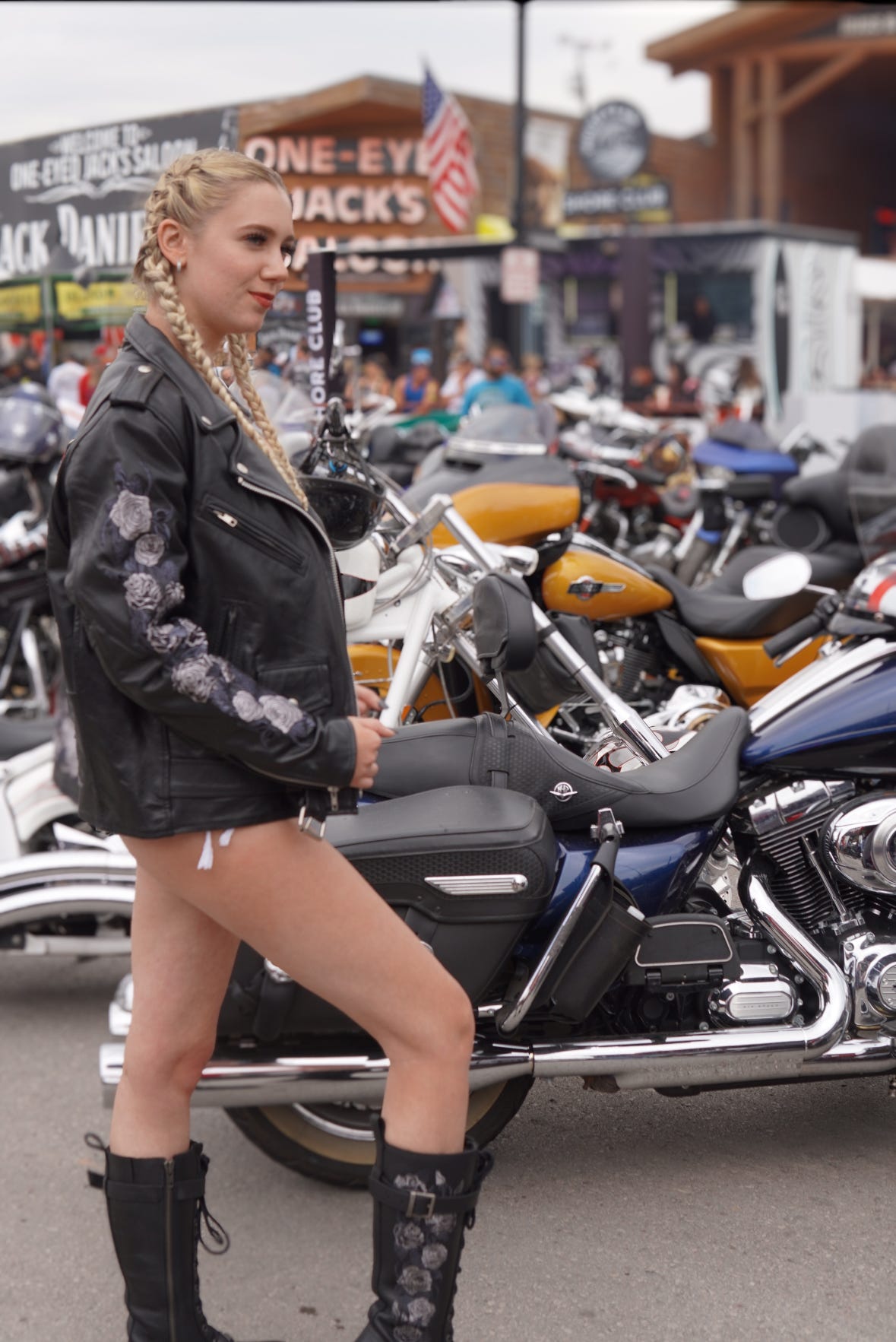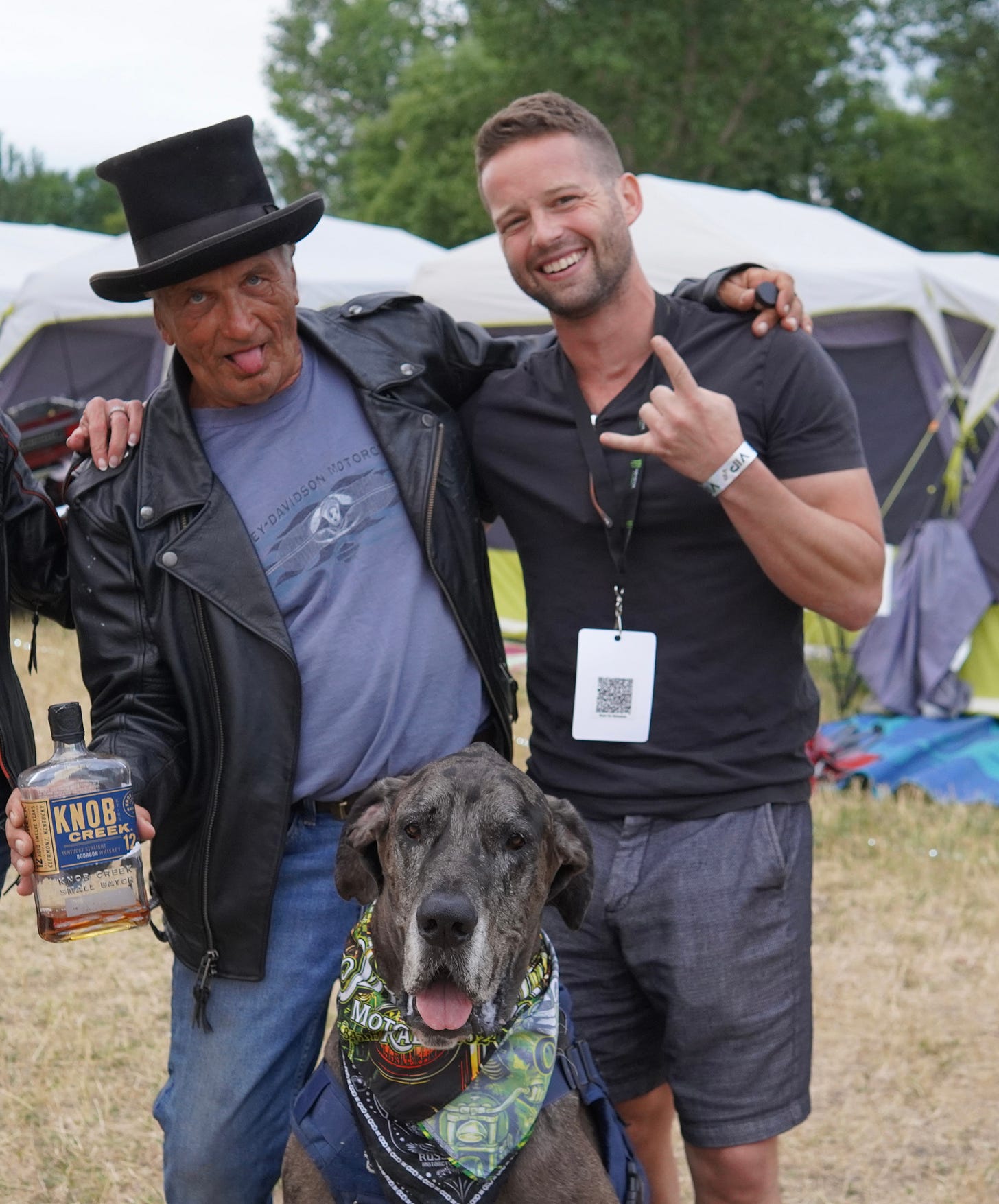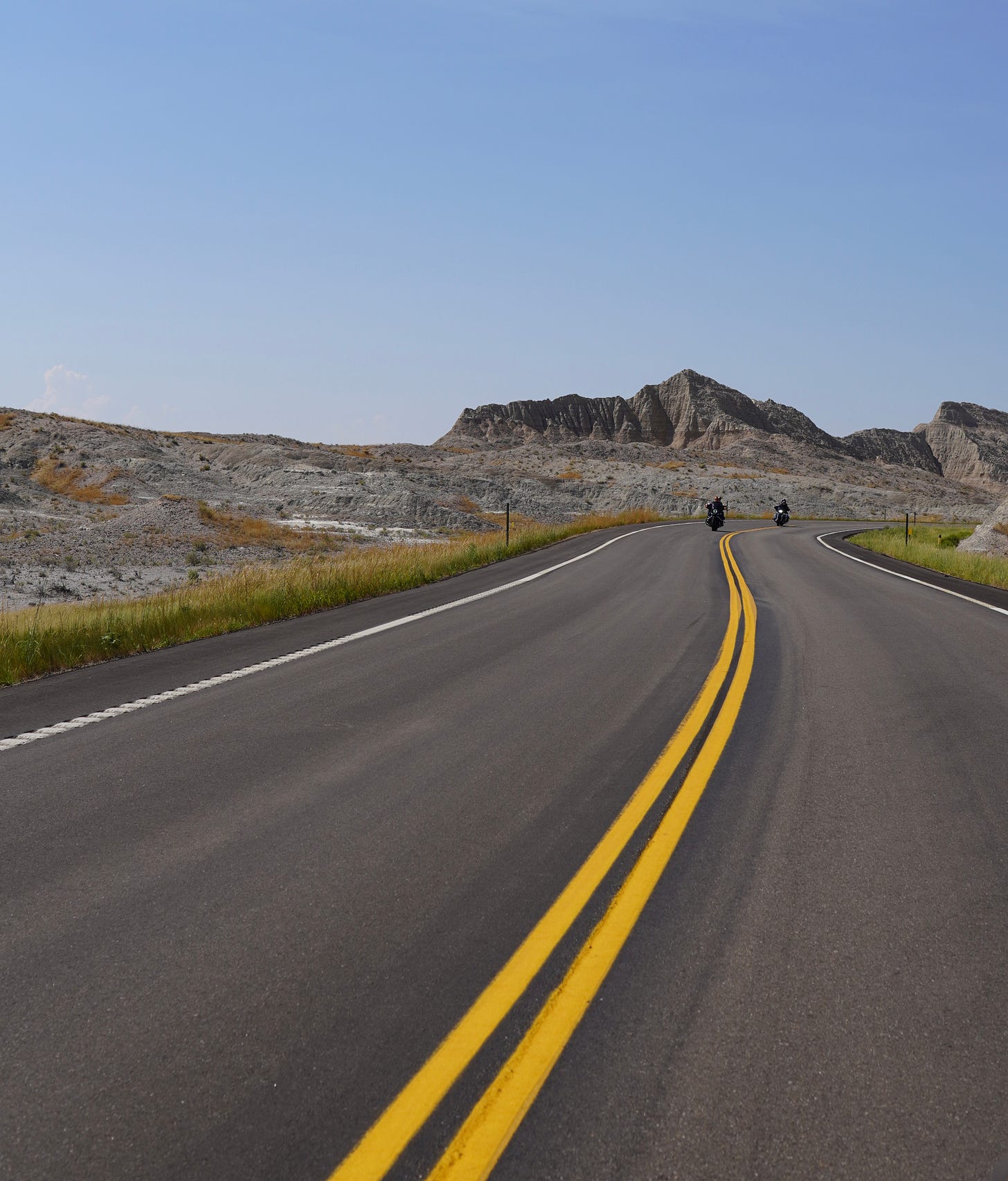Dispatches from the World’s Largest Motorcycle Rally
The shriek of motorcycle engines jolted me awake at the crack of dawn. After a brief reprieve between 3 and 6 a.m., bikers had resumed their burnouts on the road behind my tent. The stunt involved holding a motorcycle in place while spinning the rear tire rapidly against the asphalt—a thunderstorm of smoke and screaming pistons.
I travel most of the year and often wake up unsure where I am during those first groggy moments of consciousness. But on this particular morning, the din of engines and gruff voices a few yards from my head instantly told me where I was: Sturgis, South Dakota, at the largest motorcycle rally in the world.
I turned over on my air mattress and noticed something red and lacy tangled in the covers—panties belonging to the stripper who had left my tent a few hours earlier. I smiled despite my viscous hangover. She was everything I wanted from South Dakota—a prairie angel with blonde hair down to her waist, icy blue eyes, and features as striking as a Valkyrie’s.
The smell of cigarettes and fresh coffee wafting from the campground roused my courage to face the day. As I threw on a shirt, I noticed a spiderweb of black ink on my left bicep. Right, I had done something else with the stripper last night: visited the makeshift tattoo parlor at the festival grounds. My freshly inked Vegvísir, a Viking compass, looked pretty good considering the circumstances. Fuck it, I thought. If anyone raises an eyebrow back home in New York City, I’ll say it’s in honor of my Swedish grandmother.
Having never driven a motorcycle, I was an unlikely attendee at the Sturgis Rally—akin to someone indifferent to EDM traveling halfway across the country to UltraFest. Each August, over a million motorcyclists converge on Sturgis, a tiny town in the Black Hills, for the 10-day rally, an annual tradition since 1938. Sponsored by the likes of Harley-Davidson, Budweiser, and Jack Daniel’s, the Rally showcases races, Evel Knievel-style stunts, and avant-garde bikes. It’s also one of the most badass rock ’n’ roll extravaganzas in America, the reason I happily accepted an invitation from Travel South Dakota. Mix Coachella with a state fair, then smoke the whole enchilada in motorcycle exhaust, and you have Sturgis.
I helped myself to coffee in the outdoor kitchen at Camp EasyRide and surveyed the early-morning carnage. A blow-up doll drifted amid a flotilla of beer cans in an inflatable swimming pool. Somewhere, a boombox was playing a raunchy Bloodhound Gang song I hadn’t heard since eighth grade. A man with iron-gray hair and a leather jacket was nursing a beer while polishing his Harley, gleaming with chrome and powder-blue trim.
Beyond the campgrounds, an undulating, tawny savannah stretched to the horizon. The Black Hills are holy ground for the Lakota Sioux, where some of the fiercest battles of the Old West were fought. This is the land of Crazy Horse, Sitting Bull, and Black Elk; the arid, scrubby heart of the North American continent; an unbroken belt of grass stretching from Alberta to northern Mexico.
The Sturgis Rally grew legendary in part because the roads in South Dakota are so majestic. Motorcyclists come to the Rally from every corner of the continent, often riding for days across mountains, deserts, and prairies. The reward of the long journey to the Black Hills, one of the least densely populated corners of the U.S., are near-empty roads looping through Ponderosa Pine forests, oceanic grasslands, and gnarled canyons.
A couple I knew from Florida emerged from their tent. An upside-down plastic pineapple adorned the entrance of their tarpaulin domicile, which I learned was a symbol for swingers, or, as my Floridian co-campers said, “those of us in the lifestyle.”
“Well, good mornin’, cowboy,” the woman drawled. She was in her forties, with bleached blonde hair, a tongue piercing, and tattoo sleeves. “Looks like you made some local friends last night.” She winked and offered me a Marlboro Red.
“Something like that,” I said, gratefully accepting the dart.
The day before, I’d gone with her and her husband to Bikini Beach, an outdoor swimming pool lined with bar kiosks. We spent the afternoon draining rounds of Jack and Coke, courtesy of Travel South Dakota’s largesse, while watching the Deepthroat Contest, in which contestants stuffed cucumbers into their mouths. Scoring was based on both depth and showmanship. A septuagenarian, who removed her dentures before taking the stage, emerged victorious.
“We’re going to the main stage around 8 p.m. for Buckcherry,” the woman said. “Bring the cute blonde, too.”
Everyone I met at Sturgis, even the hardest-looking bikers, was welcoming in this manner. As I had learned from a long career of solo travel—often through dicey places—respectful manners and self-deprecating humor went a long way. On my first night at Camp EasyRide, a biker busted my balls about my preppy attire. As bald, rotund, and hefty as a bowling ball, he sported a T-shirt with the words Comfortable with Violence.
“The fuck are you doing here?” he asked, his tone more jocular than aggressive.
I told him I was a journalist, to which he replied, “Shit, man, you should write about my life. It’s wilder than a whore on acid.” With that, he offered a pull from the bottle of Jim Beam in his hand.
Camp EasyRide sat within The Buffalo Chip, the largest and most famous venue at Sturgis, where over half a million visitors spread out in RVs and tents across a 600-acre expanse, formerly a family farm. The Chip hosted the Rally’s biggest musical acts—Jelly Roll, Buckcherry, and Hinder this past year—and buzzed with pop-up bars, tattoo shops, and even a nightclub graced by topless waitresses.
Several other venues dotted the Black Hills during the Rally, each pulsating with tens of thousands of people, concerts, and carnivalesque revelry. Glencoe Campground, a few miles from the Chip, was notorious for Caligulan debauchery like public sex, orgy tents, and quantities of brain-rattling chemicals that would embarrass Hunter S. Thompson. Think Burning Man with a motorcycle fetish. Another venue, Kickstands Campground, hosted my favorite Red Dirt metal band, Texas Hippie Coalition.
There were also unofficial campgrounds for 1-Percenters, outlaw bikers. The epithet came from a famous statement from the American Motorcycle Association that while 99% of motorcyclists were, in fact, law-abiding citizens, 1% were criminals who tarnished the image of motorcycle culture writ large. 1-percenters were the two-wheeled pirates responsible for the stereotypes of bikers as meth-cooking, bar brawling, gang-banging brutes—Uncle Jack in Breaking Bad or the hell-raisers in Sons of Anarchy. 1-percenters flaunted their outlaw status with pride, wearing a diamond enclosed around a “1%” patched on their jackets. I came across a group of them at a gas station outside the town of Deadwood but resisted the temptation to chit-chat.
While waiting for the Buckcherry show, I hit the road to explore the Black Hills. Spattered with handsome small towns steeped in outlaw and cowboy history, the Black Hills are as rich in Wild West lore as in natural splendor. In Sturgis, a 20-minute drive from the Chip, I wandered the streets, admiring the saloons and stately brick architecture. Side streets reserved for motorcycle parking looked like a mythical god-king’s stables, stocked with gleaming teams of chrome-armored horses. As with the Chip, the attitude in town was devil-may-care, with open-container laws decidedly placed on pause.
I walked by a patio bar and saw an open seat. The bartender was a biker chick wearing a neck chain looped around a set of brass knuckles. “They ain’t illegal if you can say it’s jewelry,” the bartender, Amber, explained. She was originally from Connecticut but had moved to Black Hills to start over. She made most of her yearly income bartending during the Rally.
A sign above the bar read, “Ask About the Hurricane Shot,” so I did.
“It’s my favorite drink to serve,” Amber said. “And I think you might like it, city boy.”
I passed her a $20 bill, and she came back with a bottle of tequila.
“Stand up and hold your hands behind your back,” she instructed. “Now tilt your head back and close your eyes.” Like a mother bird feeding her fledgling, she poured the liquor down my open gullet. As soon as I choked it down, she threw a large cup of ice water in my face. Recovering from the cold shock, I saw her open palm whizzing toward my jaw before—SMACK! I saw stars as the bar erupted in laughter.
“Congratulations. You survived a hurricane,” she said. My ears rang, but I felt very awake.
I drove on to Mount Rushmore, where biker clubs from all over the United States had come to pay their respects. They had their club names and hometowns stitched to the back of their jackets, and I observed clubs from Guam, Alaska, Los Angeles, and Choctaw Nation of Oklahoma. Motorcycle mania is as universally American as capitalism, mega-churches, or baseball.
In Badlands National Park, in the final hour of daylight, I pulled into a scenic overlook to admire the rock spires and canyons, stone as twisted and colorful as a Dalí dreamscape. The road below me was a writhing rattlesnake twisting through red-yellow wastelands. While much of South Dakota is flat prairie, the topography of the Badlands is as surreal as the surface of an alien moon. After a few minutes, I heard a faint roar in the distance as a lone motorcycle came tearing up the road below me. I watched him disappear around a rock tower, the last rays of sunset turning the chrome of his bike into an orange blaze.
I drove back to the Chip to catch Buckcherry, the grand finale of my Sturgis adventure before flying home the next morning. A caravan of bikes roared past my Toyota Camry, and I felt envy mixed with awe. At this stage in life, I knew I would never take up motorcycles, but my time in the Black Hills instilled in me a profound respect for these machines—poetry written in gears, pistons, chrome, and paint. Bikers view their motorcycles the way Arab bedouins do their horses: a vehicle but, to a greater extent, an object of beauty. I have driven my car all across America, but I will never appreciate the country’s raw beauty—the foreboding deserts of New Mexico, the majestic forests of the Pacific Northwest, the rolling farm country of Pennsylvania—to the same degree as a man communing with the elements on a motorcycle.
And although I was officially dubbed “the softest guy at Sturgis,” biker culture held undeniable appeal to me. Motorcycle riding is dangerous—if you’re skeptical, ask a life insurance actuary—but every biker I met spoke the same refrain: nothing makes you feel as alive as soaring down an open road on two wheels. Facing down fear, and possible death, the mind becomes glued to the present moment. Every twist of the accelerator inches the rider closer to earthly Nirvana. The biker is an archetype of the manly thirst for adventure and risk; through him flows the spirit of the cowboy, the knight-errant, and the Viking. Ulysses, forever seeking to sail beyond the horizon, and Gilgamesh, the hero who sought to conquer death, are his spiritual brothers.









We love a good mystery tattoo